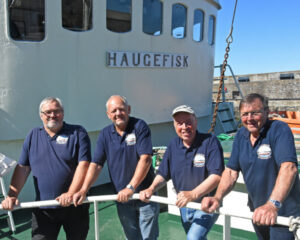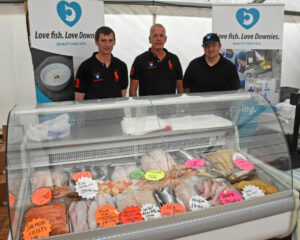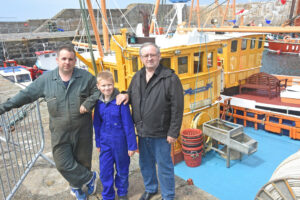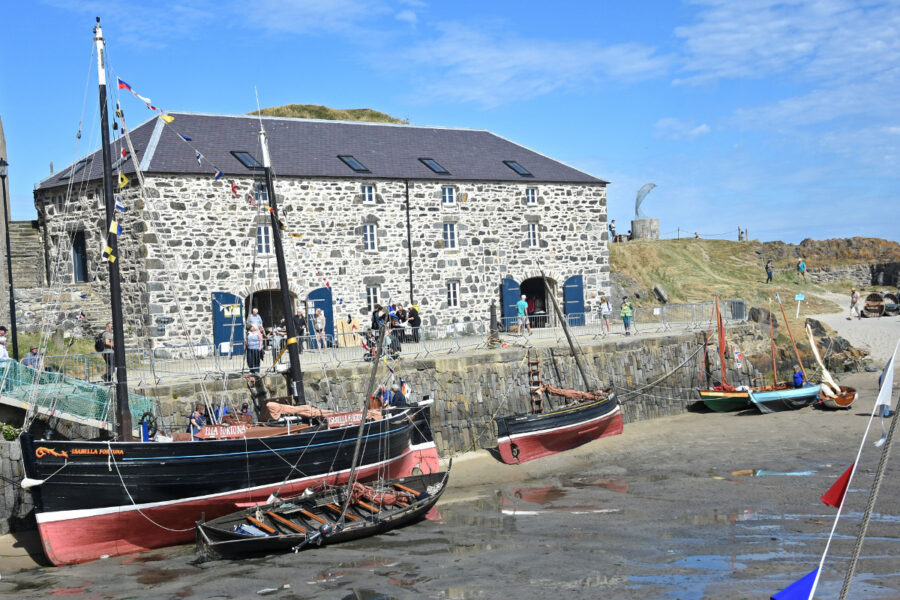Thousands of visitors sample local fresh seafood and fishing heritage, during sun-drenched weekend festival at Portsoy
Attractions including iconic vessels from previous eras, skiff racing, live music and dancing, art, craft and food fairs, international exhibitions, and search and rescue air/sea exercises, provided something for everyone at the 25th Scottish Traditional Boat Festival, held at Portsoy over the weekend of 30 June and 1 July, reports David Linkie
The extensive range of attractions and programmed events, together with the glorious sunny weather, is thought to have attracted an estimated record attendance of around 20,000 visitors to the small Moray Firth town of Portsoy, and in particular to the inner and outer harbours.
Originally held as a one-off celebration to mark the tercentenary of Portsoy harbour, the popular event has taken place every year since then, to recognise and celebrate the maritime history and present-day sea activities that abound in North East Scotland.
While the Scottish Traditional Boat Festival is clearly underpinned by bringing a wide range of older vessels together from all parts of Scotland and beyond, it also provides a unique opportunity for people from all backgrounds to broaden their experience, knowledge and understanding of the North East of Scotland’s rich cultural and natural heritage.

Malvin Grenstad, Kåre Jarl Landgeland, skipper Grie Skare and Ola Martin Grotle wait for the flood tide, before leaving Macduff harbour to head west along the Moray coast to Portsoy.
That up to 10 times the population of Portsoy – the original name for which is thought to have come from Port Saoithe, meaning ‘saithe harbour’ – is testament to the extensive planning of the festival committee, which consists of 25 members, including co-chairmen Roger Goodyear and Keith Newton.
A major development for 2018 saw an expanded international programme, including craft skills and food stalls from Estonia and Latvia.
Norway was also strongly represented by the presence of Forbundet KYSTEN (Coastal Federation), formed in 1979 to protect Norway’s coastal and maritime cultural heritage from neglect and growing centralisation.
Forbundent KYSTEN also arranged for the Norwegian museum ship Haugefisk, a former longliner, to make its first visit to the festival. The 32.2m Haugefisk was built by Vik and Sandvik at Fitjar, Hordaland, in 1978. Designed for longline fishing in the North Sea, North Atlantic and Barents Sea, Haugefish has the distinction of being the first Norwegian longline boat to feature a full-length shelterdeck.
When Haugefisk lost her quota in 2003, the unique vessel, which is powered by an Alpha 660hp main engine, was taken over by the Coastal Museum in Song og Fjordane. Two years later, a major restoration process was initiated, part-funded by Norway’s Ministry of Fisheries and Coastal Affairs, the Directorate for Cultural Heritage, and several private sponsors.
Due to her size, Haugefisk berthed at Macduff each night, where the vessel was open to view, before heading west along the coast as the tide came in shortly before lunchtime on Saturday and Sunday, to come close in to Portsoy.
‘Due to her size, Haugefisk berthed at Macduff each night, where the vessel was open to view, before heading west along the coast as the tide came in’
Haugefisk’s attendance was made possible by the generous support of local companies, which stepped in to provide fuel when the Norwegian government withdrew its previous commitment to cover this considerable expense.
A number of well-known Scottish-built ex-sail-driven fishing boats, some of which are more than 100 years old, were berthed along the quays of the tidal inner harbour, where the old grain store provided a suitably historic backdrop.
The biggest of these vessels was the Wick-based Isabella Fortuna. Of 45ft LOA, beam 13ft 9in and a draft of 6ft, Isabella Fortuna was launched by James Weir of Arbroath in 1890. Rigged with two big lug sails and a jib, supplemented by five oars, this boat was used for line and drift-net fishing. The Wick Society bought the boat from Hobson Rankin in 1997, and since then, volunteers have been engaged in a continuous programme of renewal and restoration.
The 20ft Fifie yawl Rose Leaf, moored astern of Isabella Fortuna, provided a reminder of the smaller class of vessel that in days gone by underpinned countless fishing communities. The clinker-planked Rose Leaf has a single dipping lug. After falling into disrepair, Rose Leaf was relaunched in 2014, having been brought back to life by her current owners and the Scottish Fisheries Museum boatyard.
The 33ft baldie White Wing was berthed on the other side of the inner harbour. Built in 1917 by James Cadger at Gardenstown for John Ritchie of Whitehills, this boat is a version of the Fifie lug sail design. Still fishing as recently as the early 1980s, White Wing is now owned by the Scottish Fisheries Museum, after being painstakingly restored to her original design.

Portsoy Pipe Band kick-started proceedings on each morning of the festival.
Because of her size, the 67ft Shetland sailing Fifie Swan was moored in the outer harbour. Ninety years after being built at Lerwick, the Swan returned home after being found at Hartlepool. After the Swan Trust was formed in 1990, the Fifie was extensively rebuilt in Lerwick over a six-year period, before starting her new life as a sail training vessel.
Now privately owned and kept in pristine condition at Fraserburgh, the former Macduff lifeboat Douglas Currie lay immediately astern of Swan. The 48ft 6in Solent-class lifeboat was built by Groves Gutteridge in 1973.
Accommodating these boats, in addition to an array of classic yachts, in the confined space available at Portsoy, was not an easy task, but it was achieved smoothly due to the detailed forward planning of harbour master Duncan Mackie and Alistair Scott, and the boat-handling skills of all concerned.
On both afternoons, the Buckie Severn-class lifeboat William Blannin, together with the Macduff inshore lifeboat and the search and rescue helicopter Bond 1, reminded large crowds of spectators, assembled on suitable vantage points, of the skills involved in maritime rescue, with a succession of air evacuations.
Traditional skiff racing was also a popular attraction on both days of the festival. Fifteen purpose-built St Ayles skiffs and their crews, mainly from coastal villages on the Moray Firth and in South East Scotland, as well as further afield from Co Down and the Netherlands, participated in a series of keenly-contested races outside the harbour, organised by Scottish Coastal Rowing.
Showcase for traditional local seafood
The presence of a large captive audience over the course of the two-day festival provided a unique opportunity to promote locally-sourced fish, allowing visitors to enjoy freshly-cooked takeaway seafood. This opportunity was readily embraced by several well-known fish companies.

Alan Downie with some of the team from Whitehills, ready to serve the first visitors on Sunday morning.
Ian Spink travelled up from Angus to serve hundreds of freshly-cooked Arbroath smokies. After being cooked to perfection in traditional barrels covered with damp hessian, these fell away from the backbone effortlessly, before being served to an endless queue of customers. Sourced on Peterhead fishmarket and available in three different sizes, the fish were hung in pairs on racks, where they generated widespread interest, before being placed in the barrels. The tempting aroma of billowing smoke proved a stimulus too strong to ignore for many.
Across on the other side of Portsoy harbour, Sutherlands made good use of its quayside processing premises, handing over countless servings of cullen skink, fish and chips, and kippers.
New-season herring in oatmeal and kippers also proved popular at the Food Fayre on Wally Green, just a couple of minutes’ walk from the harbour, where Downies of Whitehills hosted a popular fresh fish stall and a fish and chip van. This too met high levels of demand from locals and visitors alike, all eating their choice of seafood with a smile on their face.
That most of the fish prepared and served on the day held MSC accreditation, and was sourced from sustainable and well-managed fisheries, is also significant, as is the fact that many people left the festival promising to eat more fresh fish, having in some cases enjoyed their first taste of it.
Room for further growth – festival co-chairman Roger Goodyear
Roger Goodyear, co-chairman of the festival committee, said: “It is extremely encouraging to see so many people interacting with, and clearly enjoying, their time at the Scottish Traditional Boat Festival. In 1993, a committee was formed to organise what initially was expected to be a one-off event, to celebrate the tercentenary of Portsoy harbour. People in the town thought it was a good idea, so here we are 25 years later, already planning ahead for 2019.
“In the early years, people appeared to be turning away from the sea, with little attention being paid to local and national maritime heritage. It should always be remembered that Portsoy wouldn’t exist if it wasn’t for the sea.

Roger Goodyear.
“The exceptionally good weather this weekend means that we are on course to establish a record attendance, of around 20,000 people.
“This in itself is a fantastic achievement, and one that everyone who has contributed should be proud of. It is also a great opportunity to promote the present-day fishing industry, as well as celebrate previous eras.
“Seafood is a very important part of the festival, both on the quaysides and at the Food Fayre on Wally Green. There is room for more fish-processing companies from North East Scotland to engage in the festival, in the course of which they will also be promoting the fishing industry by showcasing fresh fish in an iconic setting.
“To any company possibly thinking about being involved next year, please support us, as all we want to do is support you.”
That Roger Goodyear found time to speak to Fishing News as thousands of people were descending on Portsoy harbour bears testament to the countless hours of detailed organisation and planning the committee had put in during the preceding 12 months, including producing a 125-page event management plan.
All money generated by the festival goes to Portsoy Community Enterprise. This encompasses a variety of local attractions, including the Salmon Bothy Museum, traditional boatbuilding in the historic boatshed, and the Sail Loft Bunkhouse. The festival also supports the teaching of traditional wooden boatbuilding skills in the nearby Banff Academy, and in conjunction with the North East Scotland Fisheries Local Action Group, has recently engaged a skilled boatbuilder to work in the boatshed (Fishing News, 7 July).
Comet and Comrades
For many boat enthusiasts, the sight of the former 54ft Whitehills seine-netter Comet BF 430, lying alongside the similar-sized ex-Shetland fly-shooter Comrades LK 325, was one of the highlights of the festival.

Billy Milne, owner of Comrades and Comet, with his son Jim and father Billy Milne.
Comet was built by Alexander Noble and Sons Ltd of Girvan in 1961, with the help of a Highlands and Islands grant, as the ring-netter Magdalena CY 203, for Donald and John Galbraith of Barra. Five years later, the boat was bought by John Watson and the late John Cowie of Whitehills for £14,500, at a public auction in Stornoway. Renamed Comet and rigged for seine-netting, the boat was extensively modernised in 1977, when a new wheelhouse, Gardner engine and rope reels were fitted.
Duncan Munro of Carradale bought Comet in 1987, when the boat was initially converted for prawn trawling, and later for scallops. In 2003, Comet was one of only a few boats allowed to be sold on outside of fishing, when approved for decommissioning, being bought by Mark Willis of Lismore. Comet returned to familiar waters in 2012, when it was bought by Billy Milne of Macduff. The boat has subsequently been well looked after by three generations of the family, including Billy Milne senior, Billy Milne and his 11-year-old son Ellis ‘Jim’ Milne, who took Comet out of Macduff harbour with a skill that many an older skipper would have admired.
Comrades was bought by Billy Milne from Hamnavoe skipper Willie Robertson towards the end of 2017. This transaction saw Comrades return to her place of origin, as the traditional herring drifter/seine-netter was built by John Watt of Banff for skipper Tommy Hutchison and a Whalsay partnership in 1958. Powered by a 240hp Gardner engine, Comrades moved from Whalsay to Scalloway in 1992.
As maintaining two former fishing boats with a combined age of over 100 years is a time-consuming task, Billy Milne is grateful for the support he receives from Kevin Stirton, another former local skipper.








